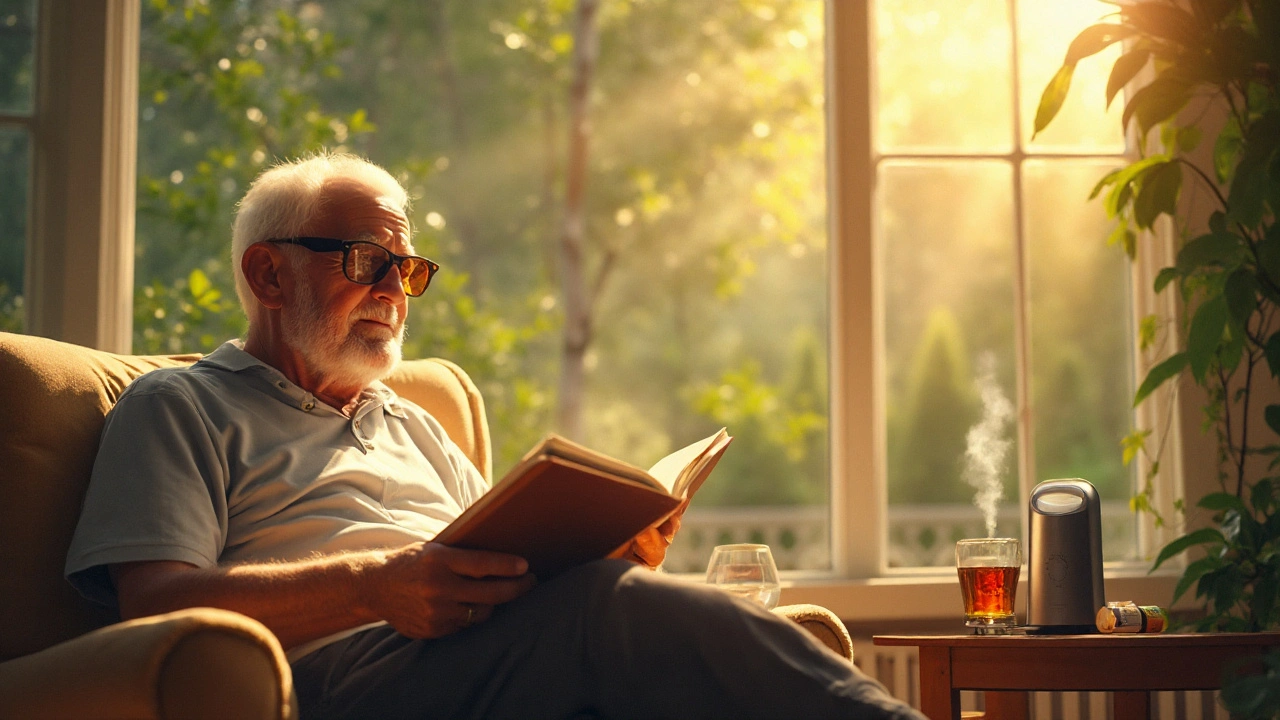Ocular Hypertension is a condition where intraocular pressure (IOP) stays above the normal range (typically >21mmHg) without obvious damage to the optic nerve. When pollen counts climb in spring or summer, many people notice itchy, watery eyes - a sign of Allergic Conjunctivitis, an inflammation of the conjunctiva caused by histamine release. The irritation and swelling can, in turn, affect the eye’s fluid dynamics, occasionally nudging IOP higher. If you already have ocular hypertension, that seasonal bump could be the push toward glaucoma.
Why Intraocular Pressure Matters
Intraocular pressure is the fluid pressure inside the eye, measured in millimetres of mercury (mmHg). Normal IOP ranges from 10‑21mmHg. Intraocular Pressure (IOP) is maintained by a balance between aqueous humor production and drainage through the trabecular meshwork. When the balance tips, pressure spikes, stressing the delicate optic nerve fibres. Over years, even modest increases (22‑25mmHg) raise the risk of developing primary open‑angle glaucoma.
How Seasonal Allergies Can Raise Eye Pressure
Allergens such as pollen, mold spores, or dust mites trigger mast cells in the conjunctiva to release histamine, a compound that dilates blood vessels and promotes fluid leakage. The resulting swelling narrows the outflow pathways, slowing aqueous humor drainage. A 2023 ophthalmology study found that patients with moderate allergic conjunctivitis experienced an average IOP rise of 1.8mmHg during peak pollen weeks.
- Inflammation: Swollen conjunctiva compresses the trabecular meshwork.
- Tear film changes: Excess tearing dilutes natural lubricants, altering ocular surface tension.
- Medication side‑effects: Some over‑the‑counter decongestant eye drops contain vasoconstrictors that paradoxically increase IOP.
Lifestyle Tweaks That Keep Pressure in Check
Simple daily habits can blunt the allergy‑induced pressure surge:
- Monitor pollen forecasts: Apps and national weather services publish daily pollen counts. On high‑count days, keep windows closed and use HEPA filters.
- Cold compresses: A 5‑minute cold pack reduces conjunctival swelling, easing fluid outflow.
- Stay hydrated: Adequate water intake helps maintain normal aqueous humor turnover.
- Limit caffeine and alcohol: Both can cause transient IOP spikes.
- Exercise wisely: Moderate aerobic activity lowers systemic blood pressure, which often mirrors IOP trends.
Medication Options: From Antihistamines to IOP‑Lowering Drops
When lifestyle measures aren’t enough, targeted eye drops become essential. Two main families address the problem:
- Antihistamine Eye Drops such as olopatadine or ketotifen work by blocking histamine receptors, reducing itch and swelling.
- Prostaglandin Analogues (e.g., latanoprost, bimatoprost) increase outflow through the uveoscleral pathway, directly lowering IOP.
Both classes are safe for most adults, but they serve different purposes. Antihistamines tackle the allergic reaction, while prostaglandin analogues address the pressure itself.

Quick Comparison of Common Drops
| Attribute | Antihistamine Drops | Prostaglandin Analogue |
|---|---|---|
| Primary Purpose | Relieve allergy symptoms (itch, redness) | Reduce intraocular pressure |
| Onset of Action | 5‑10 minutes | Within 24‑48 hours |
| Duration | 6‑8 hours per dose | Once‑daily dosing |
| Common Side Effects | Transient stinging, mild blurred vision | Darkening of eyelash pigment, occasional eye irritation |
| Prescription Status | Often OTC | Prescription only |
For most allergy‑related pressure spikes, a combination approach works best: an antihistamine drop to calm the surface, plus a prostaglandin analogue prescribed by an Ophthalmologist if IOP consistently exceeds 22mmHg.
When to Seek Professional Help
Regular eye exams are the cornerstone of safe management. Schedule a visit if you notice any of the following:
- Persistent IOP readings >22mmHg across multiple visits.
- New peripheral vision loss or “tunnel vision” sensations.
- Severe eye redness that doesn’t improve with antihistamines.
- Headaches coinciding with peak allergy seasons.
An Ophthalmologist will perform tonometry, optic nerve imaging, and visual field testing to rule out early glaucoma. Early detection lets you start IOP‑lowering therapy before irreversible damage occurs.
Daily Relief Checklist
- Check the local pollen count each morning.
- Apply a cold compress for 5minutes if eyes feel swollen.
- Instill an antihistamine drop (once or twice per day as directed).
- Take prescribed prostaglandin analogue each night.
- Log IOP readings (if you have a home tonometer) and note any spikes.
- Stay hydrated and avoid caffeine after 2pm.
- Schedule a follow‑up eye exam at the end of the allergy season.
Following this routine can keep your eye pressure stable while you still enjoy the blossoms.
Related Topics to Explore Next
If you found this guide useful, you might also be interested in:
- Understanding the difference between ocular hypertension and glaucoma.
- Natural supplements that support eye health, like omega‑3 fatty acids.
- How systemic blood pressure interacts with intraocular pressure.
- Choosing the right contact lenses during allergy seasons.

Frequently Asked Questions
Can seasonal allergies cause permanent eye damage?
Allergic conjunctivitis itself rarely causes permanent damage, but the associated inflammation can temporarily raise intraocular pressure. If that pressure stays high for weeks, it may contribute to optic nerve stress and increase glaucoma risk. Prompt treatment and regular eye checks prevent long‑term issues.
Are over‑the‑counter allergy eye drops safe for someone with ocular hypertension?
Most OTC antihistamine drops (e.g., ketotifen) are safe because they don’t affect aqueous humor dynamics. However, drops labeled as “vasoconstrictors” or “decongestants” can raise IOP in susceptible eyes. Always read the label and consult your ophthalmologist before starting a new product.
How often should I measure my eye pressure at home?
If you own a portable tonometer, record IOP twice a day-once in the morning and once before bedtime-especially during high pollen weeks. Share the log with your eye doctor at each appointment.
Do antihistamine tablets affect eye pressure?
Oral antihistamines can cause mild drying of the eyes, which may indirectly affect tear film stability but they rarely impact IOP directly. If you notice increased dryness, use preservative‑free artificial tears and monitor pressure.
Is there any diet that helps lower intraocular pressure?
Studies suggest a diet rich in leafy greens (high in nitrate), omega‑3 fatty acids, and low‑sodium foods can modestly reduce IOP. Conversely, high‑caffeine or high‑sugar diets may cause short‑term spikes.
When should I switch from OTC drops to prescription medication?
If OTC drops fail to control itching after a week of regular use, or if you experience any IOP rise above 22mmHg on home readings, schedule an appointment. Your ophthalmologist may prescribe a prostaglandin analogue or another IOP‑lowering agent.

I definetly keep a cold pack handy when pollen spikes.
Keeping windows shut and using a HEPA filter has saved my eyes this spring 🌼💧.
I also log my IOP twice daily during allergy season, it really helps spot spikes.
Don't forget to stay hydrated!
I tend to notice the itchier feeling a few days before the pollen count peaks, so I start my anti‑histamine drops early.
It seems the swelling of the conjunctiva can subtly compress the trabecular meshwork, nudging the pressure up.
Drinking enough water keeps the aqueous humor turnover smooth.
Avoiding caffeine after mid‑afternoon also appears to reduce those fleeting spikes.
Overall, a proactive routine beats reacting after the fact.
Totally agree, staying ahead of the season makes a world of difference :)
Logging the numbers helped me convince my doctor to adjust the prostaglandin schedule.
From a physiologic standpoint, the histamine‑mediated vasodilation elevates episcleral venous pressure, which in turn impairs outflow facility via the trabecular meshwork.
Integrating a HEPA filtration system reduces ambient allergen load, effectively minimizing the inflammatory cascade.
Consider employing a decongestant‑free anti‑histamine formulation to avoid iatrogenic IOP elevation.
Nice breakdown! I’ve found that swapping to preservative‑free drops also cuts down on irritation.
When you’re juggling ocular hypertension and seasonal allergies, the key is to treat both the cause and the symptom concurrently.
First, identify the specific allergen triggers by keeping a pollen diary, because not all pollen types have the same inflammatory potential.
Second, use a cold compress for five minutes at the onset of swelling; the vasoconstriction from the cold helps reopen the trabecular channels.
Third, hydrate consistently-aim for at least eight glasses of water a day-to ensure the aqueous humor maintains its normal turnover rate.
Fourth, limit caffeine intake after 2 pm, as caffeine can transiently raise intraocular pressure by increasing systemic blood pressure.
Fifth, incorporate moderate aerobic exercise like brisk walking or cycling a few times a week; this lowers overall vascular resistance and can translate into lower eye pressure.
Sixth, avoid over‑the‑counter decongestant eye drops that contain phenylephrine, because they may cause paradoxical pressure spikes.
Seventh, choose an OTC antihistamine eye drop such as ketotifen that does not contain vasoconstrictors; these drops target the histamine receptors without affecting drainage.
Eighth, if your IOP consistently reads above 22 mmHg despite lifestyle measures, discuss adding a prostaglandin analogue with your ophthalmologist; these drops increase uveoscleral outflow and are effective with once‑daily dosing.
Ninth, schedule regular follow‑up appointments during the peak allergy months so that any pressure trends can be caught early.
Tenth, consider using preservative‑free formulations to reduce additional ocular surface irritation, which can otherwise exacerbate inflammation.
Eleventh, keep indoor humidity around 40‑50 % with a humidifier; overly dry air can worsen tear film instability and increase discomfort.
Twelfth, use lubricating artificial tears that are preservative‑free to maintain a healthy tear film and support ocular surface health.
Thirteenth, if you wear contact lenses, opt for daily disposables and replace them frequently during allergy season to minimize protein buildup.
Finally, maintain a balanced diet rich in leafy greens, omega‑3 fatty acids, and low sodium, because systemic nutritional factors subtly influence intraocular pressure dynamics.
By integrating these steps into a coherent daily routine, you’ll be better equipped to keep your eye pressure stable while still enjoying the spring blossoms.
Thank you for the comprehensive protocol; the structured approach will certainly aid many patients in managing both conditions effectively.
It is absolutely imperative, dear readers, to recognize that neglecting one's ocular health during allergy season is not merely a personal oversight, but a moral failing!
We have a duty, a responsibility, to monitor intraocular pressure diligently, especially when histamine‑induced inflammation threatens the optic nerve!
Failure to act, to seek professional guidance, and to adhere to prescribed regimens betrays the very principle of self‑care that underpins a healthy society!
America's healthcare system provides the best eye‑care resources, and we must use them!!!
Don't settle for sub‑par drops from other countries-insist on FDA‑approved prostaglandin analogues!!!
Stand up for your vision, protect your eyes, and demand the highest standard of treatment!!!
Some people don't realize that the pharmaceutical industry has a vested interest in keeping patients dependent on daily eye drops, which is why they'll downplay the role of natural anti‑inflammatory strategies.
The same companies that market prostaglandin analogues also fund the majority of the research that links elevated IOP to glaucoma, creating a feedback loop that benefits their bottom line.
Moreover, the push for OTC decongestant eye drops disguises the fact that many of those formulations contain hidden vasoconstrictors designed to provoke a temporary pressure rise, forcing the user back to prescription meds.
It's a subtle form of medical control, packaged as convenience.
While they're touting the efficacy of their products, they rarely mention the importance of lifestyle modifications, such as pollen avoidance and cold compresses, which are cost‑free and can dramatically reduce IOP spikes.
By staying informed and questioning the motivations behind the recommended treatment plans, patients can reclaim agency over their ocular health.
I appreciate the balanced perspective.